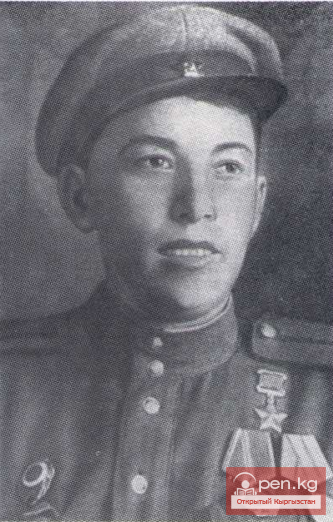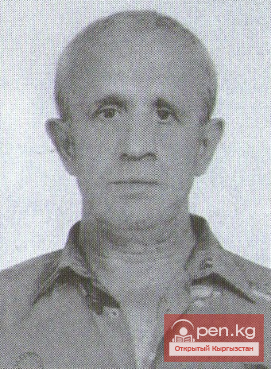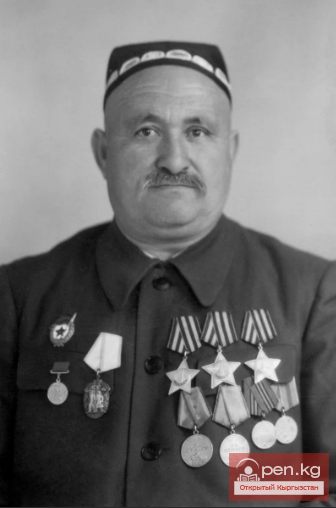
Hero of the Soviet Union Ponomaryov Pavel Sergeyevich
Pavel Sergeyevich Ponomaryov - gunner of a 45-mm gun in the 307th Guards Rifle Regiment of the 110th Guards Rifle Division of the 37th Army of the Steppe Front, Guards Red Army soldier.
He was born on January 22, 1924, in the village of Belovodskoye, Moscow District, Kyrgyzstan, in a peasant family. Russian.
He had incomplete secondary education. He worked at a meat processing plant.
He was drafted into the Red Army by the Frunze District Military Commissariat of the Kyrgyz SSR in 1943. He participated in the Great Patriotic War starting in September 1943.
As a gunner of a 45-mm anti-tank gun in the 307th Guards Rifle Regiment (110th Guards Rifle Division, 37th Army, Steppe Front), Komsomol member Guards Red Army soldier Pavel Ponomaryov, during the battles on October 3, 1943, for the bridgehead on the Dnieper near the village of Kutsovolovka in the Onufriyevsky District of Kirovograd Oblast, Ukraine, destroyed a heavy machine gun that was hindering the advance of our infantry and knocked out a tank.
On October 7, during the battles for height 177.0, together with his crew, he repelled a German counterattack consisting of 10 tanks and infantry.
Allowing them to come within 150-200 meters, he set fire to the lead tank first, and then two more, forcing the remaining seven tanks to retreat.
Through his initiative and decisive actions, Guards Red Army soldier Pavel Ponomaryov helped the infantry hold their position.
By decree of the Presidium of the Supreme Soviet of the USSR dated February 22, 1944, for exemplary performance of combat missions from the command at the front in the struggle against the German-fascist invaders and for the courage and heroism displayed during this, Guards Red Army soldier Ponomaryov Pavel Sergeyevich was awarded the title of Hero of the Soviet Union with the Order of Lenin and the medal "Gold Star" (No. 4639).
After the war, he continued to serve in the Armed Forces of the USSR. In 1946, he graduated from the Tashkent Red Banner Order of the Red Star Infantry School named after V.I. Lenin. A member of the VKP(b)/CPSU since 1947. Since 1977, Captain P.S. Ponomaryov was in reserve. He lived and worked in the capital of Uzbekistan - Tashkent. He died in 1990.
He was buried at the Alley of Heroes in the Military Cemetery in Tashkent.
He was awarded the Order of Lenin, two Orders of the Patriotic War 1st class, and medals.
DUEL ON THE BRIDGEHEAD
He was 17 years old when the greatest battle between reason and obscurantism, culture and barbarism, light and darkness began. Soon he graduated from vocational school and started working as a butcher in the sausage department of the Frunze meat processing plant. In the evenings, he attended communication courses of Osoaviakhim.
Sad news was coming from the front. The enemy, although suffering heavy losses, continued to push towards Moscow and Leningrad. In January 1942, his father and older brother went to the front. Pavel then decided that it was time for him to take up arms as well.
At the military enlistment office, an elderly officer listened to Pavel Ponomaryov and then politely and authoritatively said:
— I understand your aspirations, young man, because I also long to go to the front. But the command does not release me, an old, experienced officer, because I am needed here. I want to say the same to you. The meat processing plant lacks workers, and a soldier at the front must be well-fed and warmly dressed. Go, work, and do it as a soldier fights at the front; that will be your contribution to the swift defeat of the enemy. The time will come, and we will definitely consider your request.
After that, Pavel did not appeal anywhere else, worked hard, and waited for his moment.
And then that moment came. On January 8, 1943, the Frunze City Military Commissariat handed Pavel Sergeyevich Ponomaryov the long-awaited summons and sent him to the Almaty Mortar School. Understanding that courage and hatred for the enemy would not replace knowledge, he diligently studied the intricacies of military affairs.
In early August, without graduating from the school, Pavel arrived at the station Otrazhka in the Voronezh region as part of a group of cadets and was assigned as a gunner of a 45-mm anti-tank gun in the 307th Rifle Regiment of the 110th Guards Rifle Division. A few days later, an order was received to move to the front and pursue the retreating enemy to the Dnieper, depriving them of the opportunity to occupy advantageous defensive positions and secure themselves there.
Pavel Ponomaryov's front-line life began. Breaking the enemy's resistance, the division persistently advanced towards the Dnieper through the ruins of burned villages and settlements, where blackened chimneys stood over the ashes, and scorched fields were visible here and there... In their furious rage, the enemy left behind a dead, scorched land.
Pavel's heart was filled with fierce hatred for the fascist invaders, and he was driven by the desire to take revenge on them as soon as possible for the sufferings of the Motherland, for the blood of Soviet people, for his father, who fell heroically at the Kursk Bulge.
Fighting his way westward, on September 30, 1943, the advance detachment reached the Dnieper near Kutsovolovka, located south of Kremenchug. The Dnieper had never seemed so formidable, with fascist vultures constantly hovering over its black surface, illuminating rockets flaring up, and searchlights sweeping the shore and the river's surface, looking for possible crossing points. The Dnieper seemed to boil with the thunderous explosions of bombs, shells, and mines.
The detachment crossed the river on the move at a section where, from the point of view of the fascist command, the Russians had absolutely no chance of success. The captured small bridgehead on the right bank had significant strategic importance and served as a kind of springboard for the further advance of our troops.
Understanding this, the disheartened enemy, seeking to prevent the transfer of reinforcements, intensified bombing and shelling of possible crossing points, while concentrating infantry and tanks in the area of the bridgehead.
The division command decided to send anti-tank artillery to the bridgehead. However, due to the density of fire, the first attempts were unsuccessful. To divert the enemy's attention from the landing artillery group, the regiment commander organized a false crossing, which took the brunt of the enemy's artillery and mortar fire.
Meanwhile, in the night, shrouded in a gray veil of fog, north of the false crossing on the left bank of the Dnieper, a barely audible command was given: "Forward!" Ferries with anti-tank guns and crews on rafts made of logs, dry peasant wicker, and vines pushed off from the shore. Pavel Ponomaryov was on one of the rafts.
As it turned out later, during the crossing, the artillerymen did not lose a single person. It is hard to say what miracle allowed them to avoid the shrapnel and bullets that whizzed over the river by the thousands. The ferry did not reach the shore and ran aground. The artillerymen carried the guns and ammunition on their hands up the gently sloping bank. The infantry from the bridgehead helped them overcome the steepness of the bank and set the guns in combat positions.
Soon dawn arrived. The landing group, having received artillery reinforcements, decided to expand the bridgehead and launched an attack in the morning but was pinned to the ground by the fire of a heavy machine gun. Gunner Pavel Ponomaryov destroyed the enemy's firing point with his first shots and, following the infantry's combat formations, helped them secure more advantageous positions.
Hoping to crush the defenders of the bridgehead with a swift blow, the fascists threw tanks against them that same day, followed by automatic riflemen. Pavel, with his first three shots, knocked out a truck with enemy infantry and then set fire to a tank. The attack was repelled, and now the landing group went on the offensive, capturing the village of Kutsovolovka and creating conditions for the transfer of the main forces of the regiment to the bridgehead. For his bravery displayed in these battles, Komsomol member Pavel Ponomaryov was later awarded the Order of the Patriotic War II class.
The battles for the small patch of land grew fiercer with each passing hour... On October 7, in a moment of respite between battles, when the artillerymen were tidying up their equipment, a message came from the observation post: "Under the cover of tanks, more than a battalion of enemy infantry is moving towards the positions."
Immediately, the commander of the crew, Pyotr Kazakov, gave the command: "To your places! Prepare for battle..." He had not finished giving his order when a shell fragment struck him down. Pavel Ponomaryov took command. Meanwhile, the tanks and enemy infantry were advancing on the positions of the rifle battalion. The gunner Fedosenko began to count:
— One, two, three... ten tanks.
— You don't count the enemy in battle; you shoot them, — Pavel said emphatically, continuing to calmly observe the approaching tanks and enemy infantry firing at the positions of the assault group.
The decisive and initiative actions, the calmness of the commander, were transmitted to the crew members. They began to act in unison and briskly, preparing for a clash, the outcome of which could be decided in seconds. The ground shook from the explosions of mines and shells, and the crack of automatic fire never ceased for a moment. The enemy moved in thick chains, but Pavel did not give the command. He weighed everything and waited...
— Fire at the infantry. Shrapnel... Fire! — he finally commanded.

The enemy infantry lay down. The tanks, however, slowly continued to move forward and fire. It was already visible to the naked eye how the tracks of the lead vehicle shone, polished by grass and earth. Pavel made a decision: while the tanks had not discovered their positions, he would let the enemy vehicles get closer and with the first shell destroy the lead tank, in which, apparently, was the commander. This would at least momentarily create confusion and halt the advance of the tanks, allowing them to roll the gun out of cover and fire at the enemy directly.
Leaving behind clouds of smoke and dust, the tanks approached closer and closer. It was time, Pavel determined, and gave the command...
Like a star, the "impact point" flared up for a moment and then went out. The armored monster froze, and then began to smoke. The other tanks, stunned by this turn of events, slowed their advance, and their gun barrels began to search for cover from the artillerymen.
The gunners took advantage of the brief confusion. Ignoring the danger, they rolled the gun out of cover and, catching the vulnerable spots of the tanks in the crosshairs of their sights, fired at them directly.
The thunderous shots hit the side of the tank turning towards them; it froze, and a few seconds later exploded. The third tank threw its broken track forward like a writhing snake, causing it to rapidly turn left, exposing its right side. Pavel sent the next shells into the engine, and the tank burst into a huge fireball.
Now three tanks lay still on the battlefield. The previously orderly lines of automatic riflemen broke, and then, along with the unscathed tanks, they turned back.

The tank attack faltered. Withstanding the enemy's pressure and driving them into retreat, the infantry surged forward, along with the artillerymen. Reinforcements were arriving at the bridgehead, and their forces were growing stronger.
Fighting their way westward, the 110th captured several populated areas, seized large trophies, and took hundreds of Hitlerites prisoner. For the liberation of the city of Alexandria, the Guards Division was awarded the honorary title of Alexandrian.
Pavel Ponomaryov's crew, fighting in tank-dangerous directions, advanced with the infantry westward. They often had to drag the gun by hand, sinking knee-deep in mud, and then, exhausted, build new firing positions and engage in battle. But no one complained. They knew how much their martial labor was needed by the infantry, how much their weary people were waiting for them in the temporarily occupied territory of war-torn Ukraine.
In one of the battles on these unrecognizably rutted, beaten, and shell-pocked roads, Pavel Ponomaryov was wounded in both legs on October 26, 1943, and ended up in a field hospital near Poltava. Here he learned that by decree of the Presidium of the Supreme Soviet of the USSR dated February 22, 1944, he had been awarded the title of Hero of the Soviet Union.
The young, strong body quickly recovered from the wounds. But he was unable to return to his native Guards division.
It had moved far to the west. He was sent to the 147th Reserve Rifle Regiment located in Kirovograd. The regiment commander congratulated Pavel on his high award and asked him to tell about his heroic deed to those who were preparing to join the ranks of front-line soldiers.
The soldiers and officers settled on the lawn. They were waiting for an interesting, captivating story. Pavel came out and said:
— Fighting with a Komsomol ticket on my chest, we, like you, did not think about awards... After crossing the Dnieper, we were attacked by automatic riflemen and tanks. We were ordered to stop the enemy. We knocked out several tanks and destroyed a lot of enemy manpower. The enemy was stopped and driven into retreat. We held the bridgehead, allowed fresh forces to cross, and went on the offensive. The Motherland appreciated this as a feat. That's all.
The regiment commander had to add the following to what Ponomaryov had said:
— To better understand the significance of the feat accomplished by the Hero, one must realize that it takes desperate courage and nerves of steel to roll a gun into an open area in full view of the enemy and engage in battle with armored vehicles. After all, it is not always easy to set a tank on fire; not every hit is "fatal" for it. At the same time, to incapacitate the gunners, a direct hit is not necessary; it is enough for a shell to explode nearby. And if the artillerymen hesitate for even a second, the tank's tracks will crush them. That is why Pavel Ponomaryov was awarded the high title of Hero of the Soviet Union.
Then, addressing Pavel, the regiment commander said:
— Thank you, Hero, for your courage and bravery. In Almaty, you did not manage to finish your military education. It is time to continue your studies. We are sending you to the Tashkent Infantry School named after V.I. Lenin.
Here, within the walls of the military infantry school, when the gardens were in bloom all around, Pavel Sergeyevich Ponomaryov met Victory Day, to which he had contributed much soldierly labor.
At the end of 1946, Lieutenant Ponomaryov was demobilized from the ranks of the Soviet Army. The war hero, a communist, remained in the ranks and actively participated in labor and public life. For his impeccable work in the system of the Ministry of Trade of the Uzbek SSR, P.S. Ponomaryov was awarded the medal "For Valorous Labor" and a Certificate of Honor from the Supreme Soviet of the Uzbek SSR. Until the end of his life, he carefully kept several certificates from the military enlistment office that recognized his activities in the military-patriotic education of youth.
V. SURIN















































